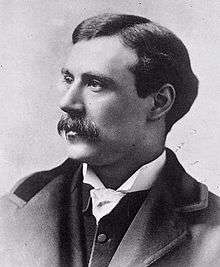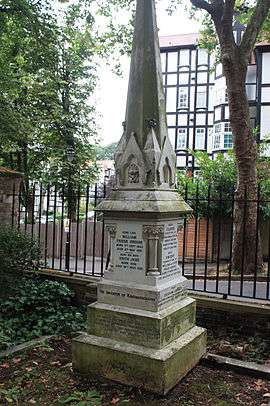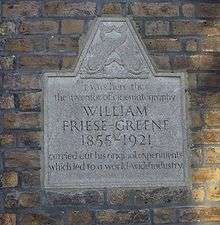William Friese-Greene
| William Friese-Greene | |
|---|---|
 | |
| Born |
7 September 1855 Bristol, England |
| Died |
5 May 1921 (aged 65) Connaught Rooms, London, England |
| Cause of death | Heart failure |
| Resting place | Highgate Cemetery |
| Residence | Cliff Road, Dovercourt, Harwich (1897 to 1904) |
| Nationality | British |
| Occupation | Inventor, photographer |
| Known for | Motion pictures, printing, photography |
| Home town | Bristol |
| Spouse(s) | Helena Friese, Edith Harrison |
| Children | Ethel, Claude, Graham, Kenneth, Vincent, Maurice, Raymond |
| Parent(s) | James, Elizabeth |

William Friese-Greene (born William Edward Green, 7 September 1855 – 5 May 1921) was a prolific English inventor and professional photographer. He is principally known as a pioneer in the field of motion pictures, creating a series of cameras in the period 1888–1891 with which he shot moving pictures in London. He went on to patent an early two-colour filming process in 1905. His inventions in the field of printing – including photo-typesetting and a method of printing without ink – brought him wealth, as did his chain of photographic studios. However, he spent everything he earned on inventing, going bankrupt three times and to jail once, before dying in poverty.
Early life
William Edward Green was born on 7 September 1855, in Bristol.[1] He studied at the Queen Elizabeth's Hospital school.[2] In 1871 he was apprenticed to the Bristol photographer Marcus Guttenberg,[3] but later successfully went to court to be freed early from the indentures of his seven-year apprenticeship.[2] He married the Swiss Helena Friese on 24 March 1874, and in a remarkable move for the era, decided to add her maiden name to his surname. In 1877 he set up his own studio in Bath, and by 1881 had expanded his business with more studios in Bath, Bristol and Plymouth.[4]
Cinematic inventor
Experiments with magic lanterns
In Bath he came into contact with John Arthur Roebuck Rudge. Rudge was a scientific instrument maker who also worked with electricity and magic lanterns to create popular entertainments.[5] Rudge built what he called the Biophantic Lantern, which could display seven photographic slides in rapid succession, producing the illusion of movement.[6] It showed a sequence in which Rudge (with the invisible help of Friese-Greene) apparently took off his head. Friese-Greene was fascinated by the machine and worked with Rudge on a variety of devices over the 1880s, various of which Rudge called the Biophantascope.[7] Moving his base to London in 1885, Friese-Greene realised that glass plates would never be a practical medium for continuously capturing life as it happens and began to experiment with the new Eastman paper roll film, made transparent with castor oil, before turning his attention to experimenting with celluloid as a medium for motion picture cameras.[8]
Movie camera
On 21 June 1889, Friese-Greene was issued patent no. 10131 for his camera.[9] It was apparently capable of taking up to ten photographs per second using perforated celluloid film. A report on the camera was published in the British Photographic News on 28 February 1890. On 18 March, Friese-Greene sent a clipping of the story to Thomas Edison, whose laboratory had been developing a motion picture system known as the Kinetoscope. The report was reprinted in Scientific American on 19 April.[10] Friese-Greene gave a public demonstration in 1890 but the low frame rate combined with the device's apparent unreliability made an unfavourable impression. In the early 1890s he experimented with cameras to create stereoscopic moving images but met with limited success.[11] Friese-Greene's experiments in the field of motion pictures were at the expense of his other business interests and in 1891 he was declared bankrupt. To cover his debts he sold the rights to the 1889 moving picture camera patent for £500. The renewal fee was never paid and the patent eventually lapsed.[12]
Colour film
Friese-Greene's later exploits were in the field of colour in motion pictures. Working in Brighton, he experimented with a system known as Biocolour. This process produced the illusion of true colour by exposing each alternate frame of ordinary black-and-white film stock through two different coloured filters. Each alternate frame of the monochrome print was then stained red or green. Although the projection of Biocolour prints did provide a tolerable illusion of true colour, it suffered from noticeable flickering and red and green fringing when the subject was in rapid motion.
In 1911, George Albert Smith and Charles Urban filed a lawsuit against William, claiming that the Biocolour process infringed upon Smith's Kinemacolor patents. William won the first round, but in 1914 the court of the House of Lords reversed the previous decision in favour of Smith and Urban. This meant that William Friese-Greene was unable to exploit the Biocolour system to its full potential. However, in 1915, the House of Lords reversed itself again, and ruled against Kinemacolor.[13] His son Claude Friese-Greene continued to develop the system during the 1920s, shooting the documentary films "The Open Road" with it, which are a rare portrait of 1920s Britain in colour.[14][15]
Death
On 5 May 1921 Friese-Greene – now a largely forgotten figure – attended an important and stormy meeting of the cinema trade at the Connaught Rooms in London. The meeting had been called to discuss the current poor state of British film distribution and was chaired by Lord Beaverbrook. Disturbed by the tone of the proceedings, Friese-Greene got to his feet to speak. The chairman asked him to come forward onto the platform to be heard better, which he did, appealing for the two sides to come together. Shortly after returning to his seat, he collapsed. People came to his aid and took him outside, but he died almost immediately of heart failure.[16]
Given his dramatic death, surrounded by film industry representatives who had almost entirely forgotten about his role in motion pictures, there was a spasm of collective shock and guilt. A very grand funeral was staged for him, a two minute silence was observed in some cinemas and a fund was raised to commission the famous architect Sir Edwin Lutyens to design a memorial for his grave. This memorial describes him as "The Inventor of Kinematography", a term William Friese-Greene never used in talking about his achievements. Indeed, he often spoke generously about other workers in the field of capturing movement.[17] He was buried in the eastern section of London's Highgate Cemetery, just south of the entrance and visible from the street through the railings.[18] His second wife, Edith Jane, died a few months later of cancer[19] and is buried with him.
Legacy
In 1951 a romanticised account of his life, starring Robert Donat, was filmed as part of the Festival of Britain. Unfortunately, The Magic Box was not premiered until the festival was nearly over, and only went on full release after it had finished. Despite the all-star cast and a great deal of publicity, the film was a costly box office flop.[20] Domankiewicz and Herbert have written, "He was the subject of a romantic and unreliable biography, Friese-Greene, Close-Up of an Inventor,[21] which was then turned into an even more misleading film, The Magic Box."[15]
Despite a campaign by Bristol photographer Reece Winstone for the retention of Friese-Greene's birthplace for use as a Museum of Cinematography, among other purposes, it was demolished by Bristol Corporation in 1958 to provide parking space for six cars.[22]

Premises in Brighton's Middle Street where Friese-Greene worked briefly in 1905 are often erroneously described as his home. They bear a plaque in a 1924 design by Eric Gill commemorating Friese-Greene's achievements, but stating, again erroneously, that it is the place where he invented cinematography. The plaque was unveiled by Michael Redgrave, who had appeared in The Magic Box, in September 1957. A modern office building a few yards away is named Friese-Greene House. Other notices include the 1930s Kings Road, Chelsea, London, Odeon Cinema, with its iconic facade, which carries high upon it a large sculpted head-and-shoulders medallion of "William Friese-Greene" and his years of birth and death. There is a bronze statue of him at Pinewood Studios.[23]
In 2006 the BBC ran a series of programmes called The Lost World of Friese-Greene, presented by Dan Cruickshank about Claude Friese-Greene's road trip from Land's End to John o' Groats, entitled The Open Road, which he filmed from 1924 to 1926 using the Biocolour process.[24] Modern television production techniques meant they were able to remove the issues of flickering and colour fringing around moving objects, which Kinemacolor and Biocolour had when projected. The result was a unique view of Britain in colour in the mid-1920s.[25]
References
- ↑ "Friese-Greene, William (1855-1921) Biography". BFI Screenonline. Retrieved 2017-10-31.
- 1 2 Davis, Bertram (March 1947). "WILLIAM FRIESE GREENE". The Elizabethan. XVIII: 10–14.
- ↑ Cosens, Ron (29 December 2017). "Marcus Guttenberg 1828 – 1891". Photographers of Great Britain and Ireland 1840 to 1940. Retrieved 29 December 2017.
- ↑ "Victorian Photographers of Great Britain and Ireland 1840-1940".
- ↑ "John Arthur Roebuck Rudge". Retrieved 29 December 2017.
- ↑ "The Biophantic Lantern". Catalogue des appareils cinématographiques de la Cinémathèque française et du CNC. Retrieved 29 December 2017.
- ↑ "Collection Will Day : les débuts du cinéma anglais". 1895, revue d'histoire du cinéma. 1997: 162, 163.
- ↑ "Celluloid and Photography part three: The Beginnings of Cinema" (PDF). National Media Museum. Retrieved 27 October 2015.
- ↑ "Friese-Greene, William (1855-1921)". Screen Online. Retrieved 27 October 2015.
- ↑ Braun, Marta, (1992) Picturing Time: The Work of Etienne-Jules Marey (1830–1904), p. 190, Chicago: University of Chicago Press ISBN 0-226-07173-1; Robinson, David, (1997) From Peepshow to Palace: The Birth of American Film, p. 28, New York and Chichester, West Sussex, Columbia University Press, ISBN 0-231-10338-7
- ↑ Zone, Ray (2014). Stereoscopic Cinema and the Origins of 3-D Film, 1838-1952. University Press of Kentucky. p. 59. ISBN 9780813145891.
- ↑ Breverton, Terry (2012). Breverton's Encyclopedia of Inventions: A Compendium of Technological Leaps, Groundbreaking Discoveries and Scientific Breakthroughs that Changed the World. Hachette. ISBN 9781780873404.
- ↑ "BBC – History – Claude Friese-Greene's Colour Process". BBC. 18 April 2007. Archived from the original on 3 December 2010.
- ↑ "Watch The Open Road - BFI Player". BFI Player. Retrieved 2018-02-15.
- 1 2 "Who's Who of Victorian Cinema". www.victorian-cinema.net. Retrieved 2017-12-29.
- ↑ "Inquiry Into Death of Mr Friese Greene". Dundee Evening Telegraph. 10 May 1926. p. 6.
- ↑ "Croydon Camera Club meeting". British Journal of Photography. 43: 703. 11 December 1896.
- ↑ "Tomb of William Friese-Greene in Highgate (Eastern) Cemetery". Historic England. Retrieved 30 December 2017.
- ↑ "Death of Mrs Friese Greene". Bath Chronicle. 23 July 1921. p. 26.
- ↑ Film and the Festival of Britain 1951
- ↑ Ray Allister (pseudonym for Muriel Forth) (1948) Friese-Greene, Close Up of An Inventor, Marsland Publications, London
(reprinted by Arno Press Cinema Program (1972) [Facsimile, Hardcover] ISBN 0-405-03908-5) - ↑ Winstone, Reece (1972). Bristol As It Was 1956–1959. Reece Winstone Archive and Publishing. pp. 57–59. ISBN 0-900814-39-X.
- ↑ "Diana Thomson FRBS". British Society of Sculptors. Retrieved 27 October 2015.
- ↑ The Open Road (2007) British Universities Film & Video Council
- ↑ The Lost World of Friese-Greene (2006) British Universities Film & Video Council,
External links
| Wikimedia Commons has media related to William Friese-Greene. |
- King's Road 1891 Early Friese-Greene test film, shot in London on perforated celluloid
- William Friese-Greene & Me Blog covering latest research on Friese-Greene
- Friese-Greene on Timeline of Historical Film Colors
- Short film about William Friese-Greene by his great grandson on YouTube.